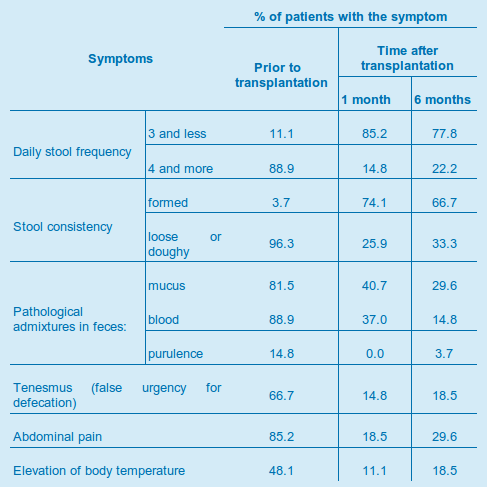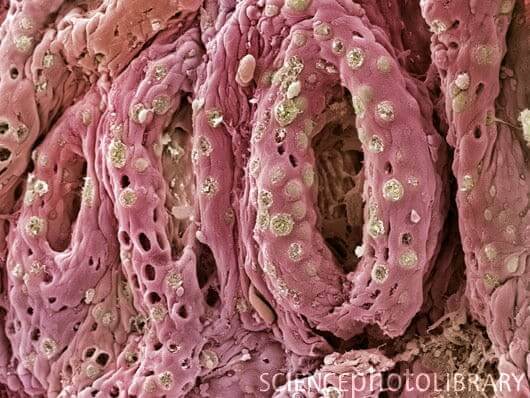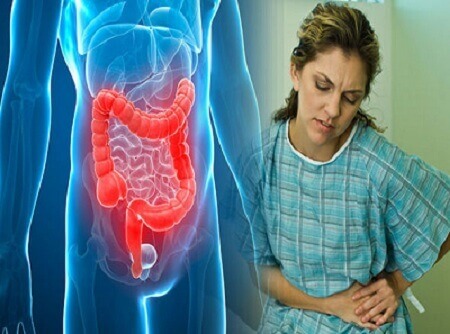Ulcerative colitis - real cure through regenerative medicine
 Ulcerative colitis and Crohn's disease are severe autoimmune diseases in which the pursued traditional anti-inflammatory therapy is symptomatic, and this disorder often causes surgery and patient’s disability. Fetal stem cells possess immunocorrecting properties and are able to stop the pathological reaction against one’s own mucosa of small and large intestines, influencing the pathogenesis (development) of the disease (ulcerative colitis). Fetal cell therapy allows to achieve a stable remission on average within 21 days in cases of nonspecific ulcerative colitis and within 28 days in Crohn’s disease (78% in nonspecific ulcerative colitis and 66.7% in Crohn’s disease). Stable remission lasts for 12-15 months in case of ulcerative colitis and as for patients with Crohn's disease it’s up to 2.5-3 years. The patient’s life quality improves (3-times decrease of defecation frequency per day is noted as well as improved stool consistency, amount of blood reduced by 45-50%, of mucus by 40-50%; elimination of pus in stools, false urgency, abdominal pain), lost working capacity is restored. In 80 percent of cases fetal stem cell therapy allows to avoid surgery and subsequent disability.
Ulcerative colitis and Crohn's disease are severe autoimmune diseases in which the pursued traditional anti-inflammatory therapy is symptomatic, and this disorder often causes surgery and patient’s disability. Fetal stem cells possess immunocorrecting properties and are able to stop the pathological reaction against one’s own mucosa of small and large intestines, influencing the pathogenesis (development) of the disease (ulcerative colitis). Fetal cell therapy allows to achieve a stable remission on average within 21 days in cases of nonspecific ulcerative colitis and within 28 days in Crohn’s disease (78% in nonspecific ulcerative colitis and 66.7% in Crohn’s disease). Stable remission lasts for 12-15 months in case of ulcerative colitis and as for patients with Crohn's disease it’s up to 2.5-3 years. The patient’s life quality improves (3-times decrease of defecation frequency per day is noted as well as improved stool consistency, amount of blood reduced by 45-50%, of mucus by 40-50%; elimination of pus in stools, false urgency, abdominal pain), lost working capacity is restored. In 80 percent of cases fetal stem cell therapy allows to avoid surgery and subsequent disability.
At the Unique Cell Treatment Clinic we have developed schemes of suspensions containing fetal stem cells in treating ulcerative colitis. Our method has shown phenomenal performance in cases of acute and chronic forms of non-specific inflammatory bowel disorder of all degrees of severity, including severe.
Indications for treatment of Ulcerative colitis and Crohn's disease with fetal stem cells:
Criteria for quality of life and clinical cure rate of nonspecific ulcerative colitis and Crohn's disease are presented in the table below:

After fetal stem cell therapy, the endoscopic aspect of the ulcerative colitis dramatically improves, anemic syndrome is corrected (red blood cell number restoration and hemoglobin level adjustment). The introduction of fetal stem cells restores immune competence - it prevents the progression of autoimmune process (the mechanism of the disorder) and re-exacerbation of the disorder.
The duration of stem cell treatment course for ulcerative colitis at UCTC usually amounts to 3 days.
 |
 |
 |
 |
Endoscopic changes and positive time course in Nonspecific ulcerative colitis on the example of patient K.
Colonoscopy of patient K. # 1 under the date of 12.10.2007 (before fetal cell therapy)Findings: Video colonoscope is inserted into the head of the blind colon. Mucosa of the blind colon and a part of the ascending colon are pale, without vascular pattern, multiple inflammatory polyps of different shapes and sizes occur. Inflammation becomes more intense towards rectum: haustra and vascular patterns are missing, the number and size of inflammatory polyps increases, mucosa of this part is hemorrhagic. A biopsy is taken from transverse and descending colons.
Conclusion: Nonspecific ulcerative colitis, total lesion.
|
|||
Colonoscopy of patient K. # 2 under the date of 23.01.08 (in 3 months after cell therapy)Findings: Video colonoscope is introduced into the head of the blind colon. The mouth of the appendix is well visualized. Lleocecal (Bauhin’s) valve is oriented into the lumen of the colon. The colon mucosa is pale, vascular pattern is without erosive damage. Multiple pseudo polyps of various sizes and shapes are seen all over the colon. Fused pseudo polyps are visualized in the sigmoid colon (“suitcase handles” syndrome). Hemorrhagic pseudo polyp groups are observed in the transverse colon.
Conclusion: Chron's disease of the colon.
|
|||
Colonoscopy of patient K. # 3 under the date of 17.04.08 (in 6 months after cell therapy)Findings: Video colonoscope is introduced 10 cm deep into the small intestine; mucosa is velvety and shiny. On the background of visually unchanged mucosa in the cecum and further pseudo polyps of different shapes and sizes (from 0.1 to 0.4 cm) are seen. In the middle third part of the transverse colon mucosa is hyperemic and tender. The number of polyps and their sizes are increasing up to polyp clusters exceeding 2-3-4 cm. Mucosa is hemorrhagic.
Conclusion: Chron's disease of the colon.
|
|||
Colonoscopy of patient K. # 4 under the date of 17.07.08 (in 9 months after cell therapy)Findings: Video colonoscope is inserted into the head of the blind colon. Shape of the folds correlates to the parts, smeared throughout the height, the tone is reduced. In all parts of the colon, mostly in its left part there are multiple polypoid formations both with peduncles and cup-headed, many of them are clustered. These formations are hyperemic. Their size is from 0.2 to 0.5-0.6 cm in height and diameter. The patient refused from biopsy.
Conclusion: Family polyposis or pseudopolyposis and ulcerative colitis.
|
|||
Colonoscopy of patient K. # 5 under the date of 17.10.08 (in 12 months after cell therapy)Findings: Video colonoscope was inserted into the head of the blind colon. The shape of the folds correlates to the parts, but their height and tone are reduced. Multiple polyps of 0.2-0.5 cm in size are found in all parts in irregular order. The patient refused from biopsy.
Conclusion: Polyposis of all parts of the colon. Family polyposis.
|
|||
Colonoscopy of patient K. # 6 under the date of 12.03.12 (in 3,5 years after cell therapy)Video colonoscope was inserted into the head of the blind colon. Intestine tract is in tone, vermicular movements, shorten. Mucosa of the rectum and lower third of sigmoid colon is edematous, hyperplastic, tender. Along intestine tract there are hyperplastic polyps 0,6-0,4-0,2. Mucosa of superposed parts is pale, thinned, haustrae are smoothed, vascular pattern is weakened. Conclusion: Unspecific ulcerative colitis, moderate activity, total lesion with more pronounced changes in rectum and lower third of sigmoid colon. |
